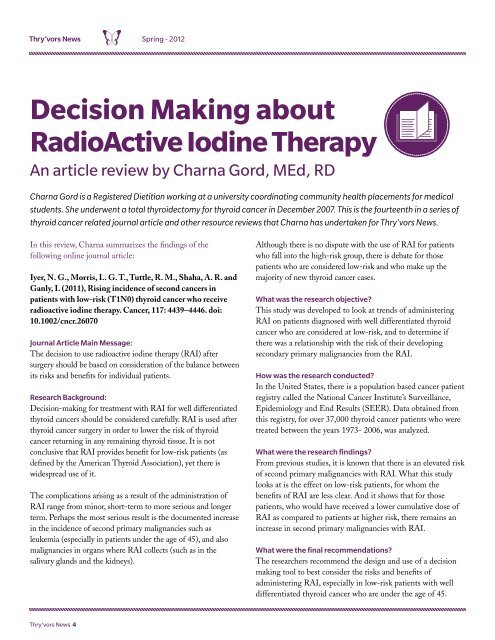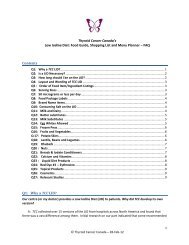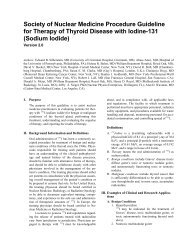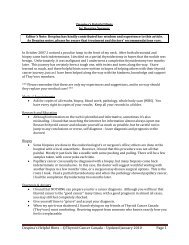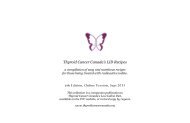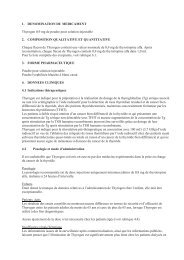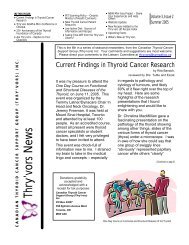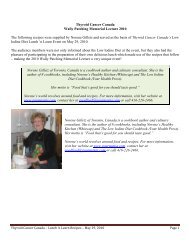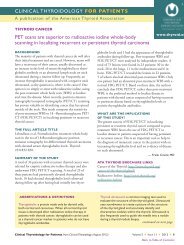Create successful ePaper yourself
Turn your PDF publications into a flip-book with our unique Google optimized e-Paper software.
JAN.Thry’vors News Spring - 2012Decision Making aboutRadioActive Iodine TherapyAn article review by Charna Gord, MEd, RDJAN.Charna Gord is a Registered Dietitian working at a university coordinating community health placements for medicalstudents. She underwent a total thyroidectomy for thyroid cancer in December 2007. This is the fourteenth in a series ofJAN.thyroid cancer related journal article and other resource reviews that Charna has undertaken for Thry’vors News.In this review, Charna summarizes the findings of thefollowing online journal article:Iyer, N. G., Morris, L. G. T., Tuttle, R. M., Shaha, A. R. andGanly, I. (2011), Rising incidence of second cancers inpatients with low-risk (T1N0) thyroid cancer who receiveradioactive iodine therapy. <strong>Cancer</strong>, 117: 4439–4446. doi:10.1002/cncr.26070Journal Article Main Message:The decision to use radioactive iodine therapy (RAI) aftersurgery should be based on consideration of the balance betweenits risks and benefits for individual patients.Research Background:Decision-making for treatment with RAI for well differentiatedthyroid cancers should be considered carefully. RAI is used afterthyroid cancer surgery in order to lower the risk of thyroidcancer returning in any remaining thyroid tissue. It is notconclusive that RAI provides benefit for low-risk patients (asdefined by the American <strong>Thyroid</strong> Association), yet there iswidespread use of it.The complications arising as a result of the administration ofRAI range from minor, short-term to more serious and longerterm. Perhaps the most serious result is the documented increasein the incidence of second primary malignancies such asleukemia (especially in patients under the age of 45), and alsomalignancies in organs where RAI collects (such as in thesalivary glands and the kidneys).Although there is no dispute with the use of RAI for patientswho fall into the high-risk group, there is debate for thosepatients who are considered low-risk and who make up themajority of new thyroid cancer cases.What was the research objective?This study was developed to look at trends of administeringRAI on patients diagnosed with well differentiated thyroidcancer who are considered at low-risk, and to determine ifthere was a relationship with the risk of their developingsecondary primary malignancies from the RAI.How was the research conducted?In the United States, there is a population based cancer patientregistry called the National <strong>Cancer</strong> Institute’s Surveillance,Epidemiology and End Results (SEER). Data obtained fromthis registry, for over 37,000 thyroid cancer patients who weretreated between the years 1973- 2006, was analyzed.What were the research findings?From previous studies, it is known that there is an elevated riskof second primary malignancies with RAI. What this studylooks at is the effect on low-risk patients, for whom thebenefits of RAI are less clear. And it shows that for thosepatients, who would have received a lower cumulative dose ofRAI as compared to patients at higher risk, there remains anincrease in second primary malignancies with RAI.What were the final recommendations?The researchers recommend the design and use of a decisionmaking tool to best consider the risks and benefits ofadministering RAI, especially in low-risk patients with welldifferentiated thyroid cancer who are under the age of 45.Thry’vors News 4


